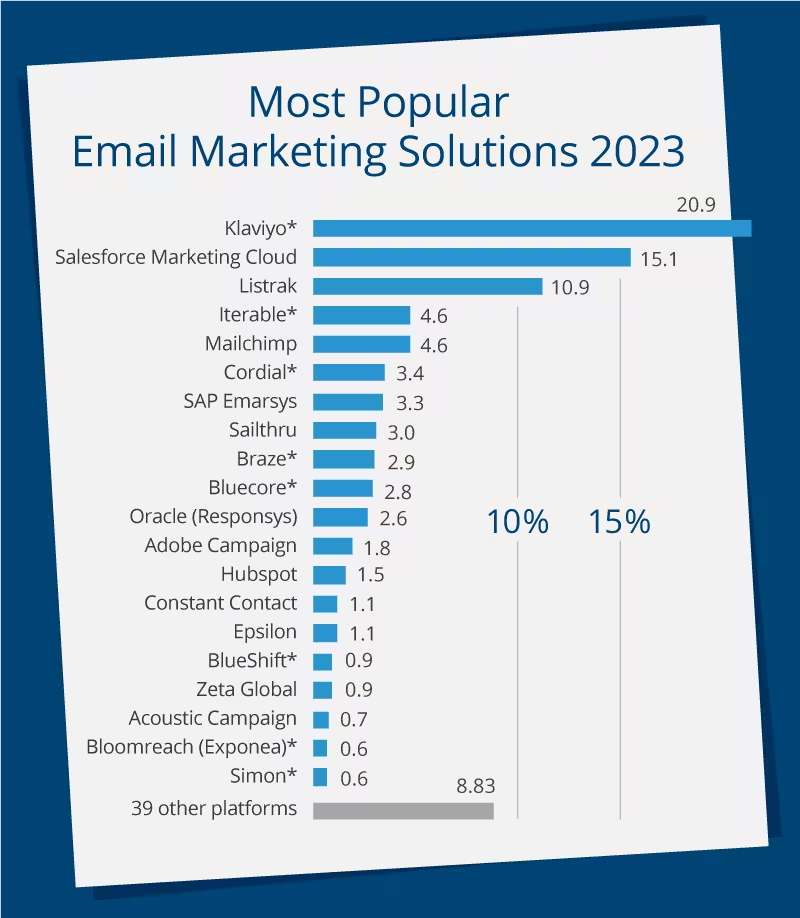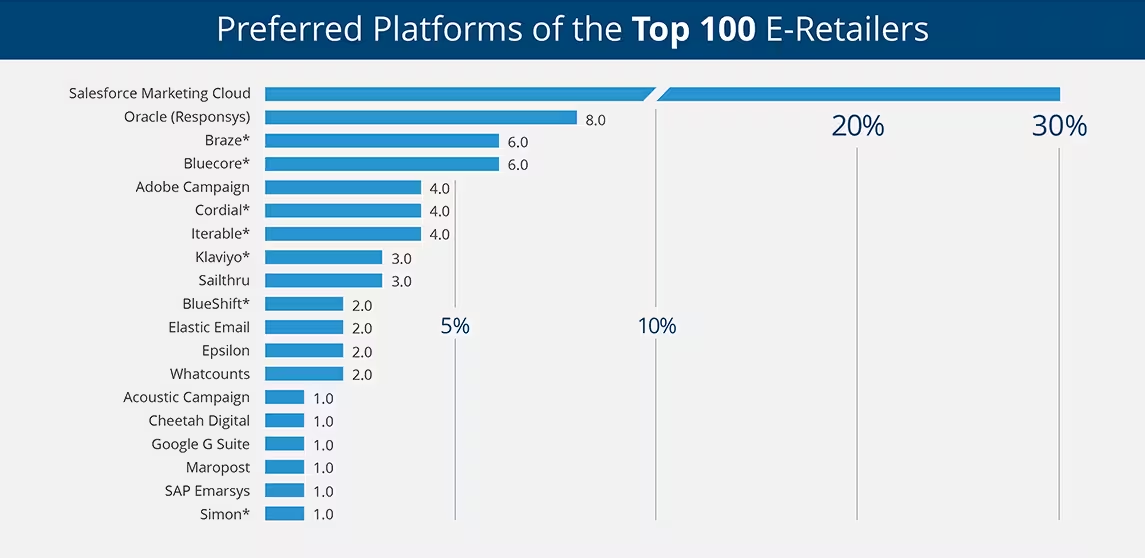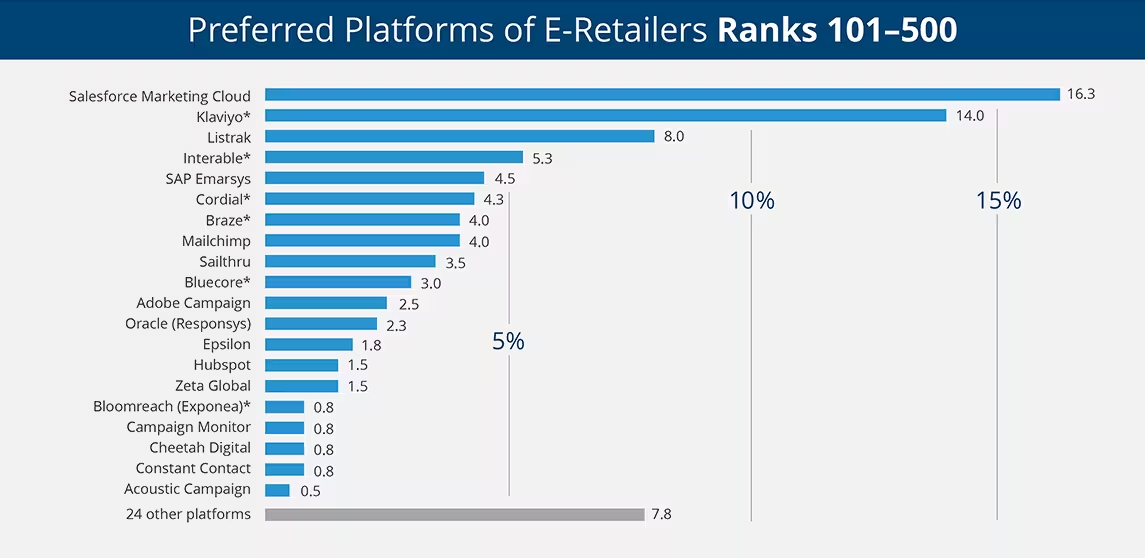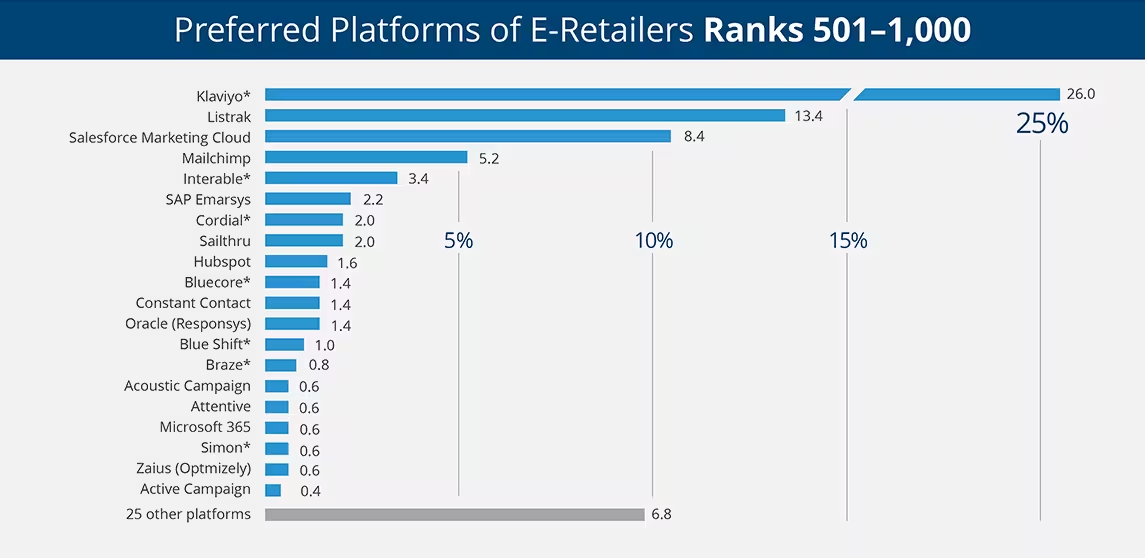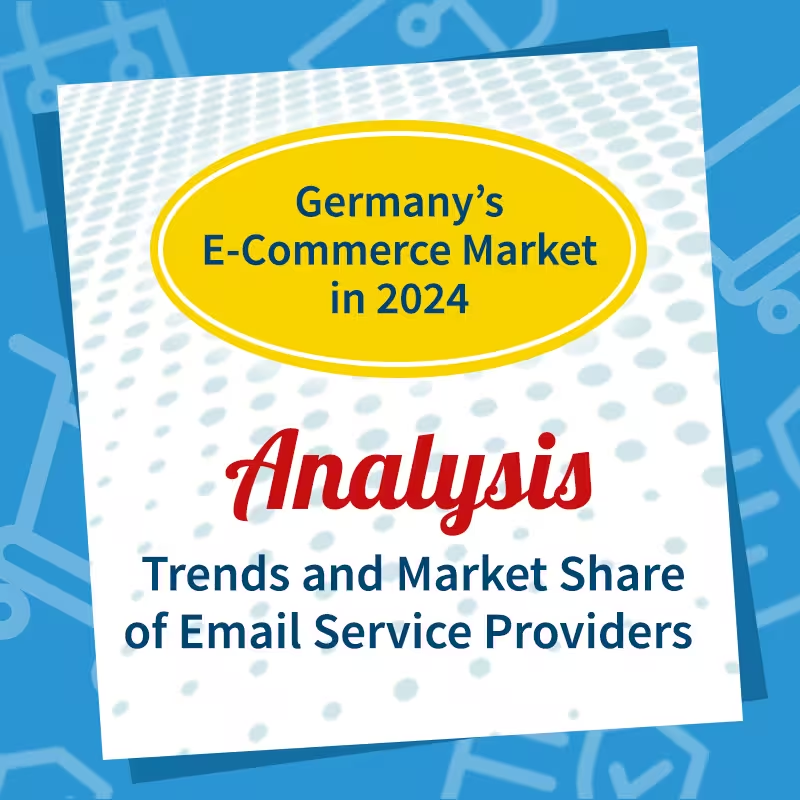Email marketing from North America's 1000 largest e-retailers
Anyone looking for a solution for professional email marketing has about as much choice as car manufacturers — there are tens of traditional brands, cheap solutions, innovative challengers and lots of (more or less similar) mid-range offers.
In contrast to the car market, however, there is no reliable overview of which solution is most commonly used in which sector. And it is surprisingly difficult to find an honest answer to this question: A population of users must be defined, the email marketing systems used in each case must be identified, and new questions constantly arise (such as evaluating solutions that use third-party sending services?). We've done all of that. With regard to the population, we were fortunately able to rely on the great work of Digital Commerce 360 and thus had the 1,000 largest e-retailers in North America (when we carried out a similar analysis in 2021, we accessed the Alexa Traffic Rank and manually selected the 1000 most frequented online shops). We subscribed to email newsletters with these shops (as far as possible) and evaluated the emails (if any were received) by email service provider (as far as identifiable). This gave us the essential information for a meaningful ranking of the most popular email marketing systems. Find out more about the methodology at the bottom of this page.

20 most popular email marketing platforms out of North America's 1,000 largest retailers in 2023
Klaviyo, Salesforce, Listrak in places 1 to 3 — are you surprised? Experts we spoke to were not surprised by the widespread use of Salesforce Marketing Cloud as a very powerful solution far beyond pure email marketing and from Klaviyo, which has grown significantly in recent years with turnkey integrations for all major online shop systems and makes it possible to easily use purchase and product data for lifecycle campaigns. For them, however, it was astonishing how strong Klaviyo's position is now — more than one in five of the 1,000 largest e-retailers use the solution in an otherwise very fragmented market. Listrak in 3rd place was unexpected for some experts, even though the solution has been around for a very long time. The high brand loyalty of some retailers may play a role here. Perhaps Listrak also benefited disproportionately from Oracle Bronto customers, who had to reorient themselves after discontinuing this service.
Read on to also see the other 39 solutions used and their market shares among the top 1,000 e-retailers in North America.
Fragmented market with a “very long tail”
These three share just under half of the market (46.9%) — the rest is spread across 56 other platforms, of which Iterable and Mailchimp are the most popular at 4.6% each. Even at 16th place, we already have a market share of less than 1%, the 39 platforms outside the “Top 20" come together to under 9% and sometimes only have a single verifiable customer among the top 1000 e-retailers. This fragmentation of the market is striking. We have already identified them in a very similar way during our annual research for the German-speaking market. We will monitor whether there is consolidation in the American market over the next few years.
An interesting dichotomy emerges when you look at the age of the providers in the top 20. The still largest number of top 20 solutions saw the light of day between 1995 and 2001. Some of these solutions may have been completely renewed over the years — but conceptually and programmatically, they are nevertheless based on a technology stack that is now quite old. These include Salesforce (formerly ExactTarget), Listrak, Mailchimp, SAP Emarsys, Oracle Responsys, Adobe Campaign, Constant Contact, Zeta Global (formerly eDialog), and Acoustic Campaign (formerly Silverpop/IBM Watson Marketing). This is contrasted by a group of providers who are technologically newer and were founded between 2010 and 2015. They include Iterable, Cordial, Braze, Bluecore, Blueshift, Bloomreach, and Simon Data. Hubspot (2006) and Sailthru (2008) are in between. It is impressive that two of the older “millennial” providers in particular remain at the top: Salesforce and Listrak. By contrast, other “classic” ESPs such as Oracle Responsys, Adobe Campaign, Constant Contact, Epsilon, Zeta Global and Acoustic Campaign are overtaken by younger players such as Iterable, Cordial, Braze and Bluecore in terms of market share. And Klaviyo, also a younger provider, has outstripped them all — including Salesforce and Listrak.
However, it is not said that these shifts will also lead to fundamental consolidation. The market may need a wide variety because the requirements of customers differ significantly. That is why we have also examined to what extent the market share situation is changing when you look at sub-areas: The 100 largest e-retailers, the “middle segment” from 101 to 500 and the comparatively “smaller” shops from 501 to 1000 (but these are not really small either, otherwise they would not be in the top 1000).
Drill down shows cost optimizers and benefit maximizers
Astonishing finding: Salesforce Marketing Cloud dominates the 100 largest shops with 30 (!) E-retailers, as many as the 6 following solutions combined — and ten times as many as Klaviyo. The reason for this is likely that Salesforce and other “enterprise” solutions such as Oracle and Adobe offer a homogenized multi-cloud portfolio, where it makes sense for customers to also use the marketing automation component of an overall system. The licensing costs here are usually relatively high, so it is plausible if rather large operators rely on such solutions. It was to be expected that Klaviyo would be less well represented here. After all, Klaviyo IS represented, while the third overall rating Listrak does not appear at all. The other younger candidates who connect sending services such as Sendgrid, Mailgun and Sparkpost for email delivery are also relatively well represented (Braze, Bluecore, Cordial, Iterable, Blueshift), which shows a certain willingness to innovate among e-retailers.
In the middle segment, we are getting closer to the overall situation, but Salesforce is still (just) ahead of Klaviyo here too. Listrak is suddenly well represented, and the previously unmentioned SAP Emarsys is also relatively strong here with 18 shops. In the “lower” area, Klaviyo is clearly the most frequently represented with 130 out of 500 shops (more than one in four!) , Listrak is well ahead of Salesforce, followed by Mailchimp. In this analysis, it is easy to see that the market segments have other solution preferences — which allow (or: require?) sales in the range of 501 to 1000 Perhaps not a multi-channel marketing automation platform, the focus is on cheaper pricing.
Our thesis: When it comes to email marketing, the e-commerce market is divided into benefit maximizers who want to get the most out of their customers with powerful tools, and cost minimizers who want to generate sales through emails with as little effort as possible. This division correlates with company size, but does not allow a fixed allocation: Among the largest e-retailers, there tend to be fewer cost minimizers, but they do exist — and so all solution classes can be found in all market segments, albeit with a different distribution.
What all of these companies have in common is an interesting fact that is not visible in the ranking: Of the 1,000 shops in the population, we received marketing emails from 906. This shows that the good old email is alive and well and an important sales tool for most e-retailers. And as long as that is the case, numerous providers will continue to seek the favor of the shops.
Webinar: “The Most Popular ESPs for US E-Retailers”
We have our results in a “Only Influencers” webinar in January 2024 presented and were supported by Chris Marriott, who commented on our findings and provided interesting insights into email marketing industry trends in North America. that Webinar can be watched on demand free of charge.
39 more platforms from the top 1,000 e-retailers in North America in 2023
Other: Sending services (no front end tool detected), etc.**
Method and population
- The population consists of the 1,000 largest e-retailers in North America, ranked by Digital Commerce 360 according to their revenue (ranked by web sales 2022). Digital Commerce 360 report date: October 2023, web revenue range: $41 million to $373 billion)
- The newsletter registrations were made on the website of the retailer's main shop (top-selling store, according to Digital Commerce 360 rankings).
- Only free email services were subscribed to. If a retailer only sends emails to buyers and not to prospects, we can't take this into account.
- 906 of these 1,000 e-retailers sent us emails during the six-month investigation period (June 2023 — November 2023).
- Platform recognition is done by analyzing email headers and email source code. In 99% of cases, we were able to identify the companies' email platforms or shipping services. However, in some cases (around 7%), we only found a shipping service, but not a front-end marketing automation solution that uses that service. Therefore. Dear email marketers, from now on, please include your platform in the header of the email!
- The percentage market share is calculated from the total number of companies that have sent at least one email. There is no weighting of companies (e.g. according to the number of emails sent or online sales); all e-retailers are counted equally.
- The analysis does not take into account whether a retailer owns more than one brand. An example: Amazon.com Inc. Main brand: Amazon.com — Amazon's other US brands (wholefoods.com, zappos.com, abebooks.com, souq.com, bookdepository.com, woot.com, comixology.com, irobot.com) are not part of the overall population.
- That should be obvious, but we emphasize it anyway: We did not rate or judge any company, no online shop, no marketing communication and no email sales platform, but only looked at the figures using a scientific approach.
* Recognized front-end tool — using a shipping service on the back-end
** Market share as a percentage, minus the percentage of e-retailers for whom we were able to identify the front-end marketing automation solution that ships via a shipping service. When we were able to identify the front-end solution, the market share was attributed to that solution.


